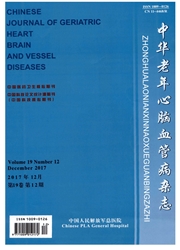

 中文摘要:
中文摘要:
目的通过对患者大脑中动脉血管反应性(CVR)与椎动脉CVR的比较,评估颅内外大动脉无狭窄但发生后循环梗死(PCI)患者CVR,探讨前后循环血流动力学变化在预测PCI发生中的作用。方法选择PCI患者27例(PCI组),选择同期健康体检者25例(对照组)。采用经颅多普勒超声结合CO2 吸入试验检测所有入选患者的大脑申动脉cVR和椎动脉CVR。结果与对照组比较,PCI组左侧和右侧大脑中动脉CVR明显下降[(25.96±15.90)%vs(34.63±8.60)%,(26.40±14.54)%vs(34.49±9.08)%,P〈0.05];PCI组椎动脉CVR较对照组有下降,但差异无统计学意义(P〉0.05)。多变量线性回归分析显示,糖尿病是大脑中动脉CVR受损的独立危险因素(β=0.116,P=0.035)。结论大脑中动脉CVR下降,而非椎动脉CVR下降,可作为颅内外大动脉无狭窄患者发生PCI预测指标。对于颅内外大动脉无明显狭窄的患者,糖尿病是大脑中动脉CVR降低的独立危险因素。
 英文摘要:
英文摘要:
Objective To assess the cerebrovascular reactivity (CVR) in patients with posterior cir- culation infarction(PCI) but without intra- and extracranial conducting artery stenosis. Methods Twenty-seven PCI patients served as a PCI group and 25 subjects undergoing physical examina- tion served as a control group in this study. The CVR in middle cerebral artery (MCA) and verte- bral artery (VA) was detected by transcranial Doppler uhrasonography combined with CO2 inha- lation test. Results The CVR in left and right MCA was significantly lower in PCI group than in control group (25.96±15.90)%vs(34.63±8.60)%,(26.40±14.54)%vs(34.49±9.08)%,P〈0.05). No significant difference was found in CVR between the two groups although it was higher in PCI group than in control group (P 〉 0. 05). Multivariate linear regression analysis showed that diabetes was the independent risk factor for CVR in MCA (β=-0. 116 ,P=0. 035). Conclusion Reduced CVR in MCA rather than CVR in VA can be used as an independent predic- tor of PCI. Diabetes is an independent risk factor for reduced CRV in MCA of patients without in- tra- and extracranial conducting artery stenosis.
 同期刊论文项目
同期刊论文项目
 同项目期刊论文
同项目期刊论文
 Tissue kallikrein protects cortical neurons against hypoxia/reoxygenation injury via the ERK1/2 path
Tissue kallikrein protects cortical neurons against hypoxia/reoxygenation injury via the ERK1/2 path Endovascular recanalisation therapy for prolonged basilar artery occlusion based on clinical-diffusi
Endovascular recanalisation therapy for prolonged basilar artery occlusion based on clinical-diffusi 期刊信息
期刊信息
